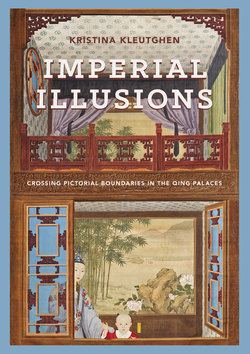Читать книгу Imperial Illusions - Kristina Kleutghen - Страница 91
Оглавлениеdu Halde recorded secondhand that Giovanni Gherardini had painted quadratura inside the French Jesuit North Church in 1703, including Pozzo’s trademark false dome:
The ceiling is all painted: it is divided into three parts; the middle part represents a dome, all open, of rich architecture. It has marble columns [that] support a range of arcades on top of which there is a nice balustrade. The columns themselves constitute a finely drawn balustrade with nicely placed vases of flowers. High above among the clouds over a group of angels, the Heavenly Father is holding the terrestrial globe in his hands. The Chinese cannot believe that all this has been painted on one plane, and cannot be persuaded that the columns are not straight as they seem to be. The light that comes through the arcades and the balustrades is so wisely painted that one can easily be deceived. . . . The altarpiece is painted too: both sides of it represent the continuation of the architecture of the church in perspective. It was amusing to see the Chinese visit that part of the church which seemed as if it was behind the altar: when they arrived at it they stopped, then stepped back a little, then forward again and put their hands on it to find out that there were really no reliefs or hollows.63
Gherardini’s paintings at the French North Church offered the first known example of Pozzo’s trademark motif in Beijing, as well as the earliest example of quadratura and the fact that Chinese outside the court were deceived by such paintings and read them as real, permeable spaces. Between 1715 and 1728, Castiglione also painted Pozzo’s false dome in the Portuguese East Church (Dongtang), and may have done so in the South Church (Nantang) as well, giving Nian multiple opportunities to experience the sort of overhead illusions he included in his treatise.64
The Jesuit churches in Beijing welcomed the public to visit. Ferdinand Verbiest recorded that nearly all officials came to Beijing at least once in their lives, and visited both the churches and the Jesuit residence: “moved by the fame of European products and by the desire to see them . . . with great admiration they contemplate long and intensely the paintings and the other European objects which we intentionally exhibit there, especially those things that reveal some work of rare skill.”65 Given the discrepancy in the elite’s ability to marvel at such paintings even as they criticized the artist’s technical skills required to produce them, the rhetoric inherent in this statement remains to be explored. But considering Nian’s connections with particular Jesuits on both the French and Portuguese missions, as well as his high official position and his time spent in Beijing, he would have had multiple opportunities to experience the illusionistic false domes in the Jesuit churches. Nian would also have been able to see Gherardini’s quadratura in the North Church and Castiglione’s quadratura on all four walls of the South Church, which included episodes from the life of the first Christian Roman emperor, Constantine I (r. 306–337). The literatus, civil official, poet, and amateur painter Yao Yuanzhi (1773–1852) described the detailed fictive architectural spaces created by Castiglione’s paintings on the east and
